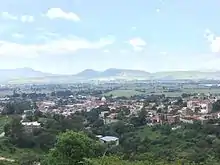Queréndaro
Queréndaro is one of the 113 municipalities that make up the state of Michoacán, Mexico. The word Queréndaro is of Chichimeca origin and means "place of rocks", from the great rock in the municipality known as "La Peña Rajada". It contains a cave with paintings that date from the pre-Hispanic era.

It is a township and municipality dedicated to agriculture, fishing, cattle breeding and bread making. The municipality produces corn, wheat, sorghum, various species of chili pepper, beans, barley, alfalfa, and chickpea, among others. At the moment it is recognized regionally, for its Feria del Chile (Fair of Chili Pepper) which is the main celebration of the municipality, celebrating the founding of the town.
Queréndaro is composed of other small towns or communities, including Pueblo Viejo and Rio de Parras, the two larger Comunidades also referred to as Tenencias. Other communities are: El Castillo, Milpillas, San Miguel Las Cuevas, El Rincon de Zetina, San Jose De La Cumbre, La Estancia, San Antonio Tiradores each having a population from 250 to 1,000 individuals. Other smaller towns like Ojo de Agua Grande, Colonia Eusebio Luna (El Zocalo), El Panteon de las Agujas, El Nopal, Ojo de Agua Chico (Ojo de Agua Chiquito), Jauja, Dolores, have between 10 and 249 inhabitants. Numerous other small towns have fewer than 100 persons. The main occupations are agriculture, fishing, cattle, pig, horse, and sheep raising.
History
Queréndaro was founded in the time of the Tarascan state. In the colonial era, it was occupied by Jesuits who used it to support and maintain their order there. The land turned out to be suitable for farming, and was also used as a rest area on the road between Morelia and Mexico City. A nearby landholding named Otzumatlán legally became part of Zinapécuaro in 1831, and a municipality in 1921, and nowadays goes by the name Queréndaro.
Location
Queréndaro is located in northern Michoacán at the coordinates 19º48 'north latitude and 100º53' west longitude, at a height of 1,840 meters above sea level. It borders the municipalities of Zinapécuaro to the east, Ciudad Hidalgo to the south, and Indaparapeo and Alvaro Obregón to the west. Its distance to the state capital Morelia is 35 km.
Extension
Queréndaro's surface area is 234.43 km² and represents 0.39 percent of the state's total.
Weather
The climate of Queréndaro is temperate, with rains in summer. It has an annual rainfall of 1165 millimeters and temperatures ranging from 4.9 to 37.0°C.
Main ecosystems
Queréndaro flora is formed by mixed forest with pine and aile tree, forest of conifers with oyamel tree and pine, and prairies with nopal, cactus, tall grasses, huizache and diverse scrub. Its fauna consists of armadilloes, coyote, hare, raccoon, opossum, skunk, hen of mount, mourning dove, duck, white fish, frogs and other species of birds and small fishes natives to the lake, mountains rivers, creeks and ponds.
Recreation
Queréndaro has a spa (El Pedregal) named for the abundance of stones where it is located. There are also 2 soccer fields, 5 basketball courts, and a sports complex with an athletics track.
Festivities and Celebrations
- March April. Holy Week, with staging of the Passion of Christ
- April 10. Celebration in honor of Jesus Lord of Love.
- May 15. Celebration in honor of San Isidro Labrador.
- August. Fair of Chile (Second Week).
- August 15. Celebration in honor of the Virgin of the Assumption patron of the town, with music and fireworks.
- September 15 and 16. Celebration of the national holidays.
- November 2. Day of the Dead
- December 12. Celebration of the Virgin of Guadalupe, with dances, music, popular dances and fireworks.
Sources
- Romero Flores, Jesús (1974). Nomenclatura Geográfica de Michoacán. Morelia, Mich., Investigaciones Lingüísticas. p. 52.
- Romero Flores, Jesús (1975). Michoacanos Distinguidos. Morelia, Mich., Cuadernos de Cultura Popular. p. 43.
- Carreño, Gloria (1989). El Pueblo que se Negó a Morir. México, D.F., Editorial, S.A. p. 121.
- Tavera Alfaro, Javier; Martínez de Lejarza J.J. (1974). Análisis Estadístico de la Provincia de Michoacán.
- Secretaría de Gobernación, Gobierno del Estado de Michoacán, Centro Nacional de Desarrollo Municipal, Centro Estatal de Estudios Municipales. Los Municipios de Michoacán. p. 532.CS1 maint: multiple names: authors list (link)
- Instituto Nacional de Estadística Geografía e Informática (1990). Anuario Estadístico del Estado de Michoacán. Aguascalientes, Méx. p. 162.
- Instituto Nacional de Estadística Geografía e Informática (1994). Anuario Estadístico del Estado de Michoacán. Aguascalientes, Méx. p. 393.
- Instituto Nacional de Estadística Geografía e Informática (1996). Anuario Estadístico del Estado de Michoacán. Aguascalientes, Méx. p. 434.
- Instituto Nacional de Estadística Geografía e Informática (1995). Resultados Definitivos Tabulados Básicos. Aguascalientes, Méx.
- Instituto Nacional de Estadística Geografía e Informática (1983). X Censo de Población y Vivienda 1980 (Cartografía Geoestadística del Estado de Michoacán). I. México. p. 171.
- Instituto Nacional de Estadística Geografía e Informática (1985). Síntesis Geográfica del Estado de Michoacán. Iztacalco, México, D.F. p. 315.
- Instituto Nacional de Estadística Geografía e Informática (1995). Resultados Definitivos Cálculos Básicos.
- Dirección General de Inspección Fiscal. Estudio Histórico, Económico y Fiscal. Tomo I. Michoacán. p. 623.
- UNAM (1979). Atlas Geográfico del Estado de Michoacán. p. 85.
- Secretaría de Gobernación, Centro Nacional de Desarrollo Municipal (1993). Gobierno y Administración Municipal en México. p. 569.
- Gobierno del Estado de Michoacán (1993). El Rumbo es Michoacán. p. 155.
- Información proporcionada por cada uno de los H. Ayuntamientos del Estado de Michoacán, 1996-1998.